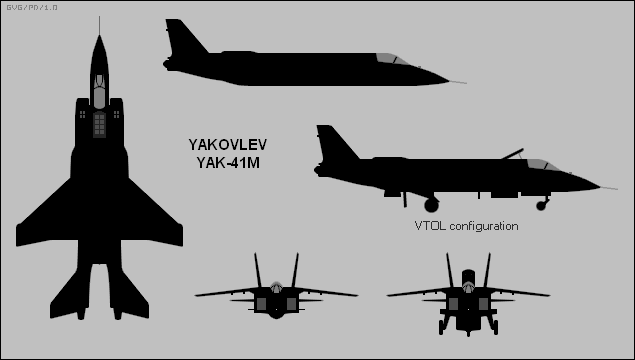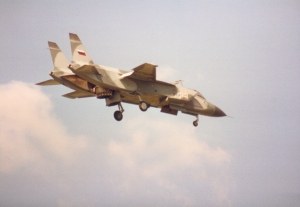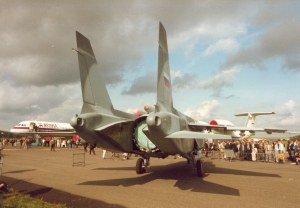F-35의 원조 신기한 YAK 41m
tae1822 | 2007-12-08 23:37:36
조회 9956 | 추천 0 | 다운로드 4
http://www.vectorsite.net/avredvt.html
http://www.aeroflight.co.uk/types/russia/yakovlev/yak-41/yak-41.htm
3] YAKOVLEV YAK-41 FREESTYLE
* Soviet-Russian design philosophy also incorporates the notion of "crawl walk run". The Yak-36 was the crawling step, the Yak-38 was the walking step; although the Yak-38 walked very poorly, the Yakovlev OKB believed they could learn from their mistakes and move on to the running step.
The OKB began with a 1983 proposal for an improved derivative of the Yak-38M designated the "Yak-39", with the same general configuration but further refined engines; a wider-span composite wing, with flaps and leading-edge slats, and a total of six stores pylons; and radar. It was an improvement on the Yak-38M, but not enough of one, and it was shot down before it got out of the paper stage. It was clearly only seen as an interim type, since the OKB was already working on a much better machine.
In 1977, even before service introduction of the Yak-38, the go-ahead was given for development of a supersonic jet VTOL fighter, the "Yak-41". Once again, four prototypes were built with only two them being flight prototypes. Development was protracted, partly because of redefinition of the aircraft to a multirole configuration, the "Yak-41M".
Initial flight of the first machine, using a conventional takeoff, was on 9 March 1987, with the chief Yakovlev test pilot, Andrei A. Sinitsyn, at the controls. The first full VTOL flight was on 13 June 1990, and the first landing on a naval vessel, the carrier-cruiser BAKU (later ADMIRAL GORSHKOV). One of the prototypes was written off after a "hard landing" accident at sea in 1991, the pilot, Vladimir Yakimov, manually ejecting safely. The Yak-41 performed impressive flight demonstrations at the Farnborough air show in the UK in 1992. The type was given the NATO codename "Freestyle".
The Yak-41M was clearly a more modern and sophisticated aircraft than the Yak-38. Although some very unusual configurations were considered in early development, as the type emerged it was of very clean and sensible design. The forward fuselage resembled that of the European Tornado strike aircraft, with the slab-sided fuselage fitted with high-mounted short wings plus twin tailfins. The trapezoidal wings had a leading-edge sweep of 45 degrees and featured both leading and trailing edge flaps. The twin tail arrangement was mounted on twin booms, with the main engine exhaust nested between the booms.
The Yak-41M was powered by a single vectored-thrust afterburning turbofan, the R-79, developed by the Kobchenko organization and with a maximum thrust of 152.0 kN (15,500 kgp / 34,170 lbf), plus twin Rybinsk (Kolesov) RD-41 liftjets in tandem behind the cockpit, each providing 40.2 kN (4,100 kgp / 9,039 lbf) thrust. The R-79 engine was fed by wedge-style inlets behind the cockpit, with four small spring-loaded relief inlets alongside and on top of each intake. The single main engine nozzle could be pivoted from vertical to horizontal and back again, and was set at 65 degrees for a short takeoff. The main engine also drove a puffer system. The liftjet arrangement much like that of the Yak-38, with the two engines mounted forward and with doors top and bottom. There was a hinged panel on the belly forward of the engine exhaust that hinged down to reduce exhaust gas reingestion; there was also a strake on the side of the bottom of the engine nacelles that had a "flap" of sorts on front, apparently also to reduce reingestion.
The Yak-41M featured a tricycle landing gear arrangement along the lines of that of the Yak-38. It featured a built-in GSh-6-30 six-barreled Gatling-type 30 millimeter cannon and had four underwing stores pylons, with a total stores capacity of 1,000 kilograms (2,200 pounds). That was a fairly modest warload for a strike aircraft, but its primary role was intended to be air combat, with strike as a secondary function.
YAKOVLEV YAK-41M FREESTYLE:
_____________________ _________________ _______________________
spec metric english
_____________________ _________________ _______________________
wingspan 10.1 meters 33 feet 2 inches
wing area 31.7 sq_meters 341 sq_feet
length 18.3 meters 60 feet
height 5.0 meters 16 feet 5 inches
empty weight 11,650 kilograms 25,690 pounds
MTO weight 19,500 kilograms 43,000 pounds
max speed at altitude 1,850 KPH 1,150 MPH / 1,000 KT
service ceiling 15,500 meters 50,850 feet
range 1,400 kilometers 870 MI / 755 NMI
_____________________ _________________ _______________________
The Yak-41M featured much more modern technology in every respect than the Yak-38. About a quarter of its empty weight was composite assemblies, and it featured an advanced avionics suite, including Zhuk Doppler radar, like that used on the MiG-29 but with a smaller antenna; a digital fire-control system linked to the radar and a helmet-mounted sight; a modernized navigation system; and a digital fly-by-wire flight control system. The flight control system performed diagnostics on the machine and would not permit takeoff if a serious failure was found. It would also auto-eject the pilot if a failure occurred in flight and the main engine nozzle was 30 degrees below the horizontal.
Compared to the Yak-38, the Yak-41 could carry much more armament and fuel; it also had more efficient engines and was designed from the outset with short takeoffs in mind, giving it much better range and endurance. Although a Russian website claimed it was the "world's first supersonic VTOL aircraft", that was nonsense, since the German VJ101 and French Mirage III-V VTOL fighters broke Mach 1 two decades earlier. However, the Yak-41 was still no slouch, setting a dozen flight records for its class. The machine was designated the "Yak-141" for the record-breaking flights; it was a typical Soviet dodge to change the designations of aircraft as a security measure for establishing international records. That was the designation by which it was known in the West for some time.
Unfortunately, since the Red Navy was acquiring real aircraft carriers and was obtaining carrier-based versions of the high-performance Su-27 and MiG-29 fighters, the Yak-41 was gradually eclipsed, and the entire program collapsed along with the fall of the Soviet Union. A projected two-seater, the "Yak-41UB", was never built.
How well the Yak-41 would have worked in operational service is an interesting question with no clear answer. From the looks and description of the thing, it was arguably a generation ahead of the Harrier. Apparently Lockheed Martin consulted the Yak organization in 1995 for data to help build the VTOL version of what would become the F-35 Joint Strike Fighter. The Yakovlev organization also developed designs for an even more impressive VTOL machine, the "Yak-43", but it never got out of the paper stage.
BACK_TO_TOP
[4] COMMENTS, SOURCES, & REVISION HISTORY
* As is often the case in documenting Soviet-Russian aircraft, it is hard to find reliable information on Soviet VTOL aircraft. Both technical and historical details tend to vary from source to source, and even designations and simple statistical tables tend to be confused and confusing. A great deal of good information on aircraft has been coming out of Russia since the fall of the USSR, and hopefully more details on Soviet VTOL efforts will be forthcoming.
제가 알기론 미국에서 F-35개발중에 테일 부분을 건설하는대 어려움이 많아 야케로브사에서 컨설팅 도움많이 받았다는걸로 알고있습니다.. 구글에서 검색하면 금방 나옴. 상당히 효율적이면서 신기술을 무기에 도입한 나라는 러시아로생각합니다 다만 금융적으로 많이 힘들기떼문에... 오히려 무기라면 미국에서 많이 카피해간거같네요.
http://www.aeroflight.co.uk/types/russia/yakovlev/yak-41/yak-41.htm
3] YAKOVLEV YAK-41 FREESTYLE
* Soviet-Russian design philosophy also incorporates the notion of "crawl walk run". The Yak-36 was the crawling step, the Yak-38 was the walking step; although the Yak-38 walked very poorly, the Yakovlev OKB believed they could learn from their mistakes and move on to the running step.
The OKB began with a 1983 proposal for an improved derivative of the Yak-38M designated the "Yak-39", with the same general configuration but further refined engines; a wider-span composite wing, with flaps and leading-edge slats, and a total of six stores pylons; and radar. It was an improvement on the Yak-38M, but not enough of one, and it was shot down before it got out of the paper stage. It was clearly only seen as an interim type, since the OKB was already working on a much better machine.
In 1977, even before service introduction of the Yak-38, the go-ahead was given for development of a supersonic jet VTOL fighter, the "Yak-41". Once again, four prototypes were built with only two them being flight prototypes. Development was protracted, partly because of redefinition of the aircraft to a multirole configuration, the "Yak-41M".
Initial flight of the first machine, using a conventional takeoff, was on 9 March 1987, with the chief Yakovlev test pilot, Andrei A. Sinitsyn, at the controls. The first full VTOL flight was on 13 June 1990, and the first landing on a naval vessel, the carrier-cruiser BAKU (later ADMIRAL GORSHKOV). One of the prototypes was written off after a "hard landing" accident at sea in 1991, the pilot, Vladimir Yakimov, manually ejecting safely. The Yak-41 performed impressive flight demonstrations at the Farnborough air show in the UK in 1992. The type was given the NATO codename "Freestyle".
The Yak-41M was clearly a more modern and sophisticated aircraft than the Yak-38. Although some very unusual configurations were considered in early development, as the type emerged it was of very clean and sensible design. The forward fuselage resembled that of the European Tornado strike aircraft, with the slab-sided fuselage fitted with high-mounted short wings plus twin tailfins. The trapezoidal wings had a leading-edge sweep of 45 degrees and featured both leading and trailing edge flaps. The twin tail arrangement was mounted on twin booms, with the main engine exhaust nested between the booms.
The Yak-41M was powered by a single vectored-thrust afterburning turbofan, the R-79, developed by the Kobchenko organization and with a maximum thrust of 152.0 kN (15,500 kgp / 34,170 lbf), plus twin Rybinsk (Kolesov) RD-41 liftjets in tandem behind the cockpit, each providing 40.2 kN (4,100 kgp / 9,039 lbf) thrust. The R-79 engine was fed by wedge-style inlets behind the cockpit, with four small spring-loaded relief inlets alongside and on top of each intake. The single main engine nozzle could be pivoted from vertical to horizontal and back again, and was set at 65 degrees for a short takeoff. The main engine also drove a puffer system. The liftjet arrangement much like that of the Yak-38, with the two engines mounted forward and with doors top and bottom. There was a hinged panel on the belly forward of the engine exhaust that hinged down to reduce exhaust gas reingestion; there was also a strake on the side of the bottom of the engine nacelles that had a "flap" of sorts on front, apparently also to reduce reingestion.
The Yak-41M featured a tricycle landing gear arrangement along the lines of that of the Yak-38. It featured a built-in GSh-6-30 six-barreled Gatling-type 30 millimeter cannon and had four underwing stores pylons, with a total stores capacity of 1,000 kilograms (2,200 pounds). That was a fairly modest warload for a strike aircraft, but its primary role was intended to be air combat, with strike as a secondary function.
YAKOVLEV YAK-41M FREESTYLE:
_____________________ _________________ _______________________
spec metric english
_____________________ _________________ _______________________
wingspan 10.1 meters 33 feet 2 inches
wing area 31.7 sq_meters 341 sq_feet
length 18.3 meters 60 feet
height 5.0 meters 16 feet 5 inches
empty weight 11,650 kilograms 25,690 pounds
MTO weight 19,500 kilograms 43,000 pounds
max speed at altitude 1,850 KPH 1,150 MPH / 1,000 KT
service ceiling 15,500 meters 50,850 feet
range 1,400 kilometers 870 MI / 755 NMI
_____________________ _________________ _______________________
The Yak-41M featured much more modern technology in every respect than the Yak-38. About a quarter of its empty weight was composite assemblies, and it featured an advanced avionics suite, including Zhuk Doppler radar, like that used on the MiG-29 but with a smaller antenna; a digital fire-control system linked to the radar and a helmet-mounted sight; a modernized navigation system; and a digital fly-by-wire flight control system. The flight control system performed diagnostics on the machine and would not permit takeoff if a serious failure was found. It would also auto-eject the pilot if a failure occurred in flight and the main engine nozzle was 30 degrees below the horizontal.
Compared to the Yak-38, the Yak-41 could carry much more armament and fuel; it also had more efficient engines and was designed from the outset with short takeoffs in mind, giving it much better range and endurance. Although a Russian website claimed it was the "world's first supersonic VTOL aircraft", that was nonsense, since the German VJ101 and French Mirage III-V VTOL fighters broke Mach 1 two decades earlier. However, the Yak-41 was still no slouch, setting a dozen flight records for its class. The machine was designated the "Yak-141" for the record-breaking flights; it was a typical Soviet dodge to change the designations of aircraft as a security measure for establishing international records. That was the designation by which it was known in the West for some time.
Unfortunately, since the Red Navy was acquiring real aircraft carriers and was obtaining carrier-based versions of the high-performance Su-27 and MiG-29 fighters, the Yak-41 was gradually eclipsed, and the entire program collapsed along with the fall of the Soviet Union. A projected two-seater, the "Yak-41UB", was never built.
How well the Yak-41 would have worked in operational service is an interesting question with no clear answer. From the looks and description of the thing, it was arguably a generation ahead of the Harrier. Apparently Lockheed Martin consulted the Yak organization in 1995 for data to help build the VTOL version of what would become the F-35 Joint Strike Fighter. The Yakovlev organization also developed designs for an even more impressive VTOL machine, the "Yak-43", but it never got out of the paper stage.
BACK_TO_TOP
[4] COMMENTS, SOURCES, & REVISION HISTORY
* As is often the case in documenting Soviet-Russian aircraft, it is hard to find reliable information on Soviet VTOL aircraft. Both technical and historical details tend to vary from source to source, and even designations and simple statistical tables tend to be confused and confusing. A great deal of good information on aircraft has been coming out of Russia since the fall of the USSR, and hopefully more details on Soviet VTOL efforts will be forthcoming.
제가 알기론 미국에서 F-35개발중에 테일 부분을 건설하는대 어려움이 많아 야케로브사에서 컨설팅 도움많이 받았다는걸로 알고있습니다.. 구글에서 검색하면 금방 나옴. 상당히 효율적이면서 신기술을 무기에 도입한 나라는 러시아로생각합니다 다만 금융적으로 많이 힘들기떼문에... 오히려 무기라면 미국에서 많이 카피해간거같네요.








 1
1


댓글 [4]
투리스트 | 2007-12-09 | 추천 0
F-35는 배기노즐이 바로아래로 꺾이는 반면 이 친구는 돌면서 꺾이죠...
F-35의 배기노즐 방식이 YAK-41/141을 보고 만들어졌다고합니다.
CHAOS | 2007-12-09 | 추천 0
마구쏘는남자 | 2007-12-09 | 추천 0
Blood4Blood | 2007-12-08 | 추천 0